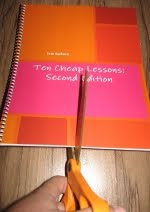At one of my favorite local haunts, patrons play a lot of
Jenga. Recently, people have started to deface (some might say enhance) the ubiquitous wooden blocks with all sorts of messages. There are directions you might give to someone for a dare ("
Kiss the person to your right!"), analog Twitter updates (
"Johnny wuz here 1-25-10"), and grammatically questionable declarations of love ("
Cap'n -n- Tennille 4 eva"). As usual, I saw an immediate, easy application to the classroom.
Let's use this idea to make a fun review for standardized test and end-of-year exams. Cover the top and bottom of each block with vocabulary, short problems, clues for a larger puzzle, etc. You can even make them into "flash" blocks, with a term or picture on one side and a concise definition on the opposite side.
Students play the game as they normally would, with one notable difference:
when they remove a block, they have to do something with whatever is on it. For example:
- In an algebra class, each block could contain linear and quadratic equations. Students could write down each equation and work with them after the game ends--each student would have a random and (mostly) different set of problems to work with. They could alternately quickly name some key piece of information about the given function, like the slope and y-intercept of the linear functions, before placing the blocks on top of the stack.
- In a social studies class, each block could contain vocabulary words that students would have to write down. After the game, students would define and illustrate the key terms, then share them within their groups to build a complete study guide.
- In a chemistry class, each block could contain individual elements or reactions that students have to explain and/or solve.
- In an English/language arts class, blocks could contain the elements of a story that students could later put together into an original story. Each piece could instead have authors and works studied during the year, and the kids would have to identify key information, write reflections, etc.
The possibilities are truly endless. If you could get several Jenga sets, each one could cover a different objective or focus on things in a different way, so that you might have to rotate the sets around so that each group of students would be exposed to everything.
If you had an extra untouched Jenga set available, I would love to see
students create their own educational Jenga game. In a perfect world, you could get funding so that each group of students would work on such a project, but this is not the case. What you could do is have one extra set available and reward students who did the best work on the earlier game to create a new version that would help other kids.
Why Jenga? Like
Uno, students can't help but being fully engrossed in this simple yet addictive game. Even if you don't see yourself using this idea, Jenga is a game that should be in every classroom.
I also must insist that you buy only real Jenga sets. The generic knock-offs are pure crap: the blocks aren't even the same size, and they don't fit together tightly the way the original does. In this case, it's worth the extra couple bucks to get the name brand.
Have you tried or seen anything like this using Jenga before? Do you have some ideas for your subject or grade level? Are you wondering how to pull this off in your classroom? Share your thoughts and questions in the comments.











